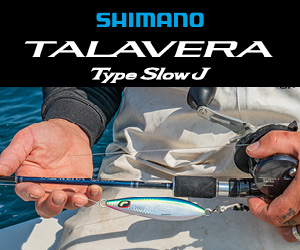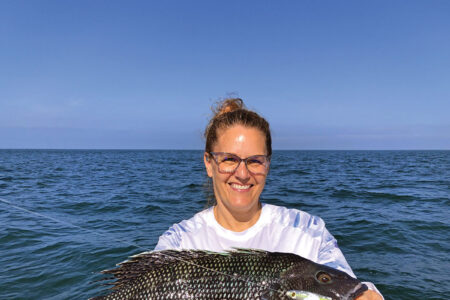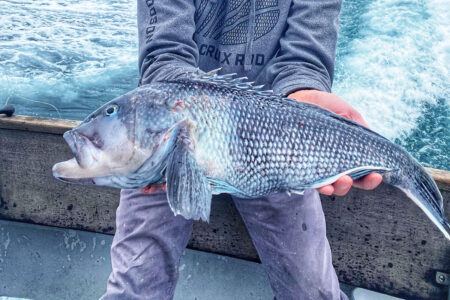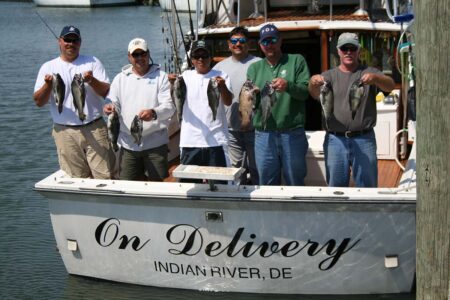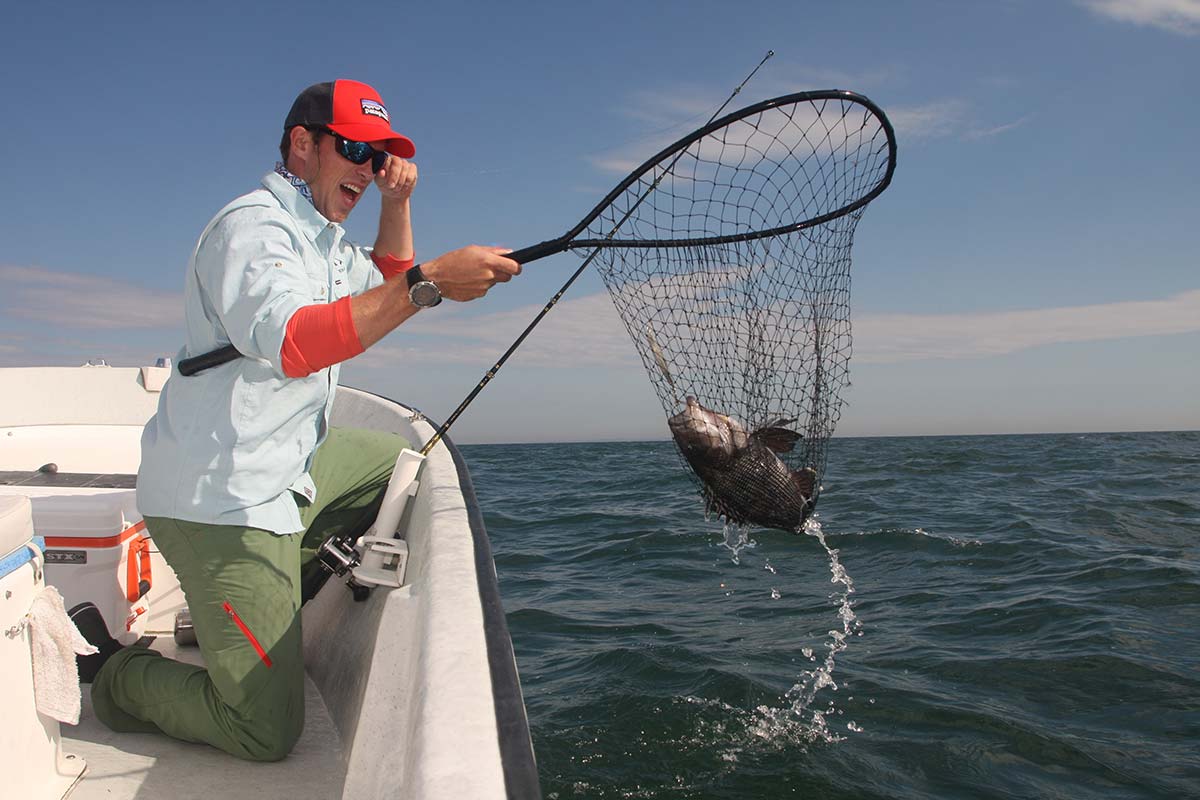
Old school lures and techniques, still result it limits of sea bass!
Starting back in the heyday of cod fishing in the 1970s, traditional diamond jigging has been my go-to method for hauling up hundreds of fish. In more recent years, diamond jigging is the most common method I use for plying deep, tide-swept reefs when targeting striped bass and bluefish.
One summer day a few years back, I was jigging for blues as I drifted over an 80-foot peak that jutted up from surrounding 120-foot-deep structure. I had an aggressive hit on my 8-ounce diamond and started pumping up what initially felt like a bluefish strike. But the fight differed, and as the battle continued I guessed maybe I had a schoolie bass or big fluke. To my surprise, it was a monster 22-inch black sea bass that had aggressively latched onto my substantial 8/0 hook!
Years ago, sea bass were a more southerly fish, but with warming coastal waters their biomass has gradually shifted north from the Mid-Atlantic to southern New England and even up into the Gulf of Maine. Since then, as most of you know, sea bass have become a highly popular fishery in our area and have supplemented the dwindling population of fluke—our other favorite summer bottom fishing target.
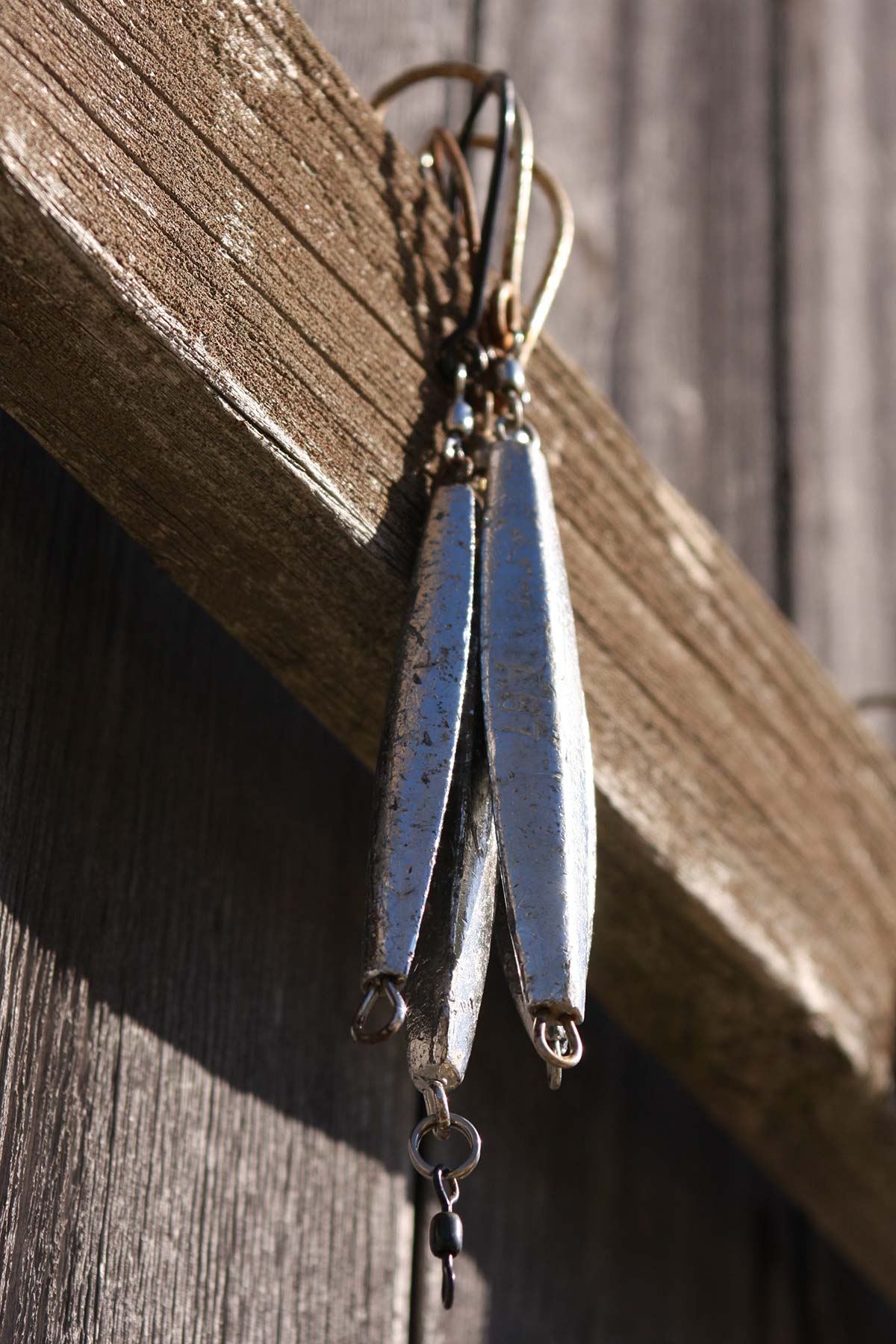
Why Diamond Jigs?
For handling, a diamond jig’s naked chrome-over-lead construction makes it extremely efficient. Diamond jigs are simple, clean, fast, and tooth-proof. Using diamonds for sea bass means no hooks to rebait and no chewed up soft plastics to replace. A diamond jig’s body also affords a sturdy and safe “handle” for lifting, holding, and unhooking feisty fish.
For performance, lures don’t get much better. Diamond jigs can plummet in the strongest current or flutter downward like wounded prey, yet they wobble irresistibly like fleeing baitfish when retrieved. During hot action, jigs offer a speedy turnaround time. As quickly as you can wrestle a diamond’s hook from the maw of a scrappy gamefish, you can immediately drop it back down to the strike zone. Diamonds are inexpensive when compared to other lures. And a few tackle shops carry “seconds” (lures with minor defects) and non-brand-name jigs, as well as selling some in bulk without hooks, making purchases even cheaper.
Besides the varied action of a diamond jig, its other key feature is the shiny, chrome-plated finish that accurately imitates baitfish. The silvery sides of baitfish like herring, peanut bunker, sand eels, silversides, and butterfish—all of which sea bass gobble—reflect the available light, which depends on depth, water clarity and amount of sunlight. On sunny days in clear water, baitfish appear mirror-like, that is, bright silver and highly reflective. However, in murky water during low-light conditions, or in great depths, baitfish become dull. The surfaces of diamond jigs perform the same way, reflecting the available natural light and therefore more closely imitating baitfish than painted lures.
As far as bait fishing for sea bass, there’s no doubt it’s highly productive, but with vertical jigging, you don’t gut or gill hook fish; therefore, releases are easy. And bait-thief pests like sand sharks, sea robins, porgies, and short sea bass won’t grab a large, fast-moving jig. Last, it’s much easier and quicker to tie on and take off a jig compared to working with messy bait and multi-hook rigs.
Fascinating History
John Schmuke, an avid saltwater angler, of the Eastern Toy and Novelty Company, created diamond jigs in the mid-1920s. The business was in Bridgeport, Connecticut, and that’s how the famous Bridgeport Diamond Jig got its name. Trying to improve his lures, Schmuke bought the Bridgeport Silverware Company in 1929, which until then only manufactured handles for caskets using lead plating, coating, and buffering equipment. Over the next few decades, Schmuke’s business grew as the design of his jigs was refined and their use began to spread with news of their effectiveness.
In 1955, Bead Tackle Manufacturing (famous for their multi-joint swivels) purchased Bridgeport Silverware, and Schmuke was retained as its director of production. In May 2000, Larry Razza and Capt. Greg Metcalf of Atom Lure Manufacturing (famous for its surface plugs) purchased Bead Chain Tackle and Bridgeport Diamond Jigs, adding the jigs to their line of popular Atom lures. Metcalf had been in the tackle industry since 1983, at which point he founded Smoker Baits. Then the Uncle Josh tackle company (known for its pork rinds) acquired the Atom, Bridgeport, Bead and Smoker Baits brands from Atom in April of 2007.
Many imitations of the Bridgeport Diamond Jig are on the market, and several others are no longer produced, but the original is still considered superior to the knockoffs. That’s because the company uses high-quality lead and buffs their jigs before plating, a process that makes the final jig shinier. Bridgeport Diamond Jigs also use thick, stainless-steel O-rings, which are much stronger and more durable than the thin brass rings used by many manufacturers.
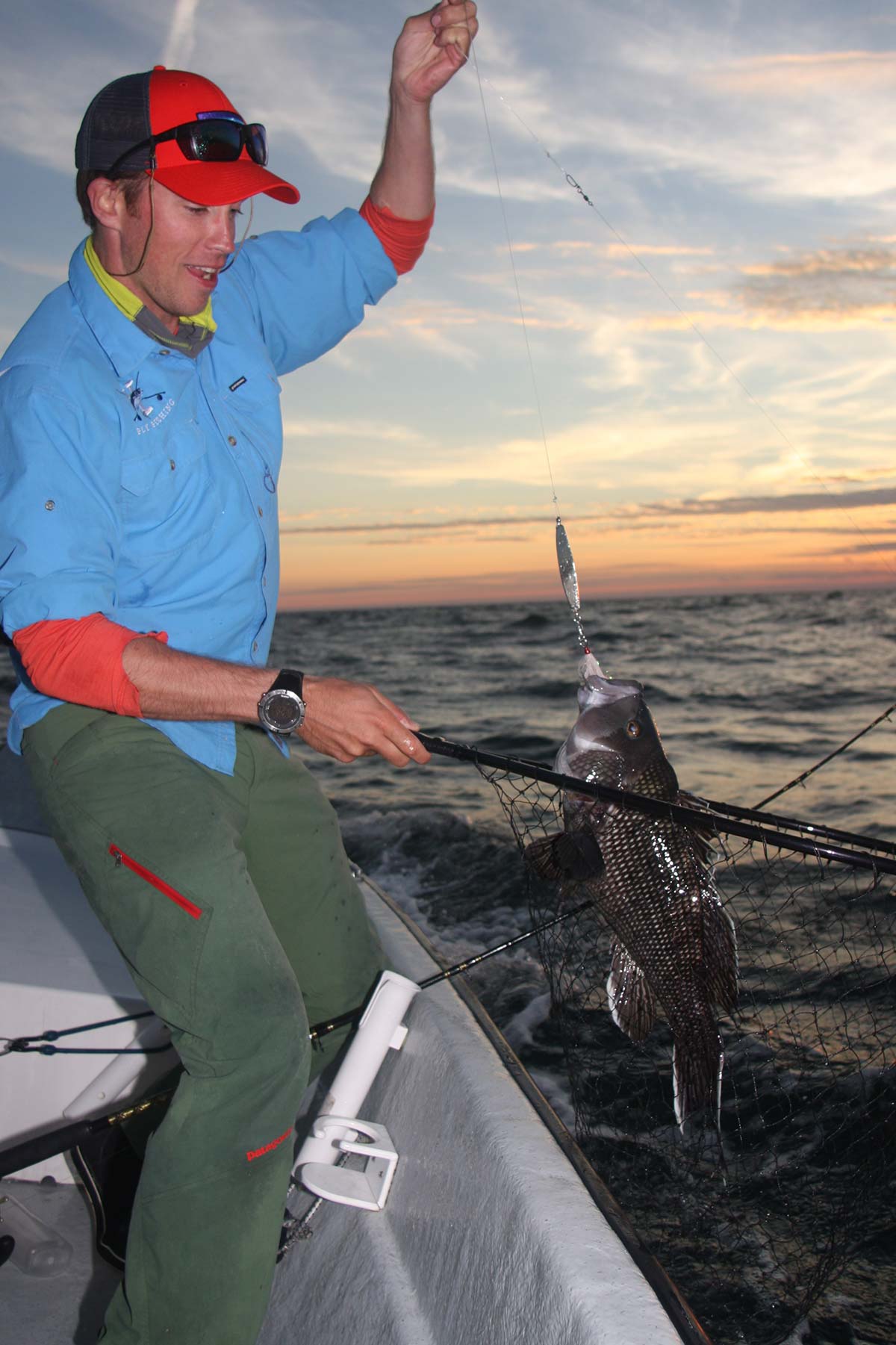
Sizes For Sea Bass
Humpback sea bass are not only aggressive, but they have bucket mouths and willingly inhale large, fleeing forage – or in this case, diamond jigs. Experts use the lightest jig they can given the wind, current, and depth, which allows for the most action and feel. On offshore spots – south of Block Island, for example – pros carry jigs up to 12 ounces. But in waters of eastern Long Island Sound, a 4- to 8-ounce diamond is perfect because it weighs enough to easily reach bottom in deep water and resembles favored prey like squid and herring.
A guideline for selecting the size of a diamond jig is to use the smallest jig possible to get the job done. Some less-experienced anglers believe the opposite and think “bigger is better” or “the bigger the bait the bigger the fish.” That may be true with live bait, but it’s doesn’t usually apply to diamond jigs. You can work a small lure with more action and less effort. A lighter jig also generates less force when shaken by a hooked fish and therefore reduces the chance of the hook wrenching free. A mathematical rule-of-thumb is if you can hold bottom with a 4-ounce diamond jig in 100 feet of water, given identical light conditions (wind and current), you’ll need at least an 8-ounce jig to hold bottom in 200 feet of water.
“When fishing shallower spots inside Buzzards Bay and Long Island Sound,” says Capt. Ned Kittredge of Westport, Massachusetts, “3 to 4 ounces is my preferred jig weight. Whatever size hooks are factory supplied are sufficient, they’re not worth changing out for sea bass, but I like treble over single hooks if the bottom isn’t too rough and there aren’t a lot of lobster traps in the area. But if it’s a rugged bottom you should switch out to singles.”
While almost any diamond-jig hook works for large sea bass, I fish boney reefs and therefore opt for a single 6/0 or 7/0 Siwash, which is small enough for jumbo sea bass but big enough if stripers or bluefish mix in.
“I personally don’t use bait anymore,” says Captain Ned. “Sea bass are hungry and aggressive. I’d rather not deal with bait if I don’t have to. Sometimes I fish with just a metal jig, but if the fish are thick or suspended just above the structure, a teaser rigged above the lure is a good idea. Sea bass will strike the jig most often, but they do sometimes hit the teaser, and you can then land a double. You can also add a bucktail teaser to the main hook for more enticement.”
Where To Find Bass
Black sea bass – which are in the grouper family – make excellent sportfish because they’re opportunistic feeders, strike aggressively, and fight hard all the way to the surface. Their varied diet includes all baitfish as well as squid and crustaceans like small crabs, shrimp, and baby lobsters.
Although not true schooling fish, pros find sea bass in clusters on structures like wrecks, reefs, and rock piles during spawning and migration periods. Adults migrate inshore and northward as water temperatures increase in the spring. The northern population of black sea bass spawns inshore from mid-May to July between Massachusetts and New Jersey, although some experts believe the spawn lasts into August in cooler areas of our region. The fish then gradually return to deeper water, moving south and offshore as sea temperatures drop in the fall.
“Almost any deep structure from central Long Island Sound through Rhode Island and southern Massachusetts is a potential sea bass jackpot,” said Q Kresser, previous manager at River’s End Tackle in Old Saybrook, CT. “Sharpies closely guard their hotspots because a fleet of boats on a patch of ground can pick it clean of big fish. But there are hundreds of productive spots in southern New England, and many are seldom fished. Your best bet is to study a chart and your depthfinder to locate and mark your own sea bass hangouts. Don’t just follow the fleet.”
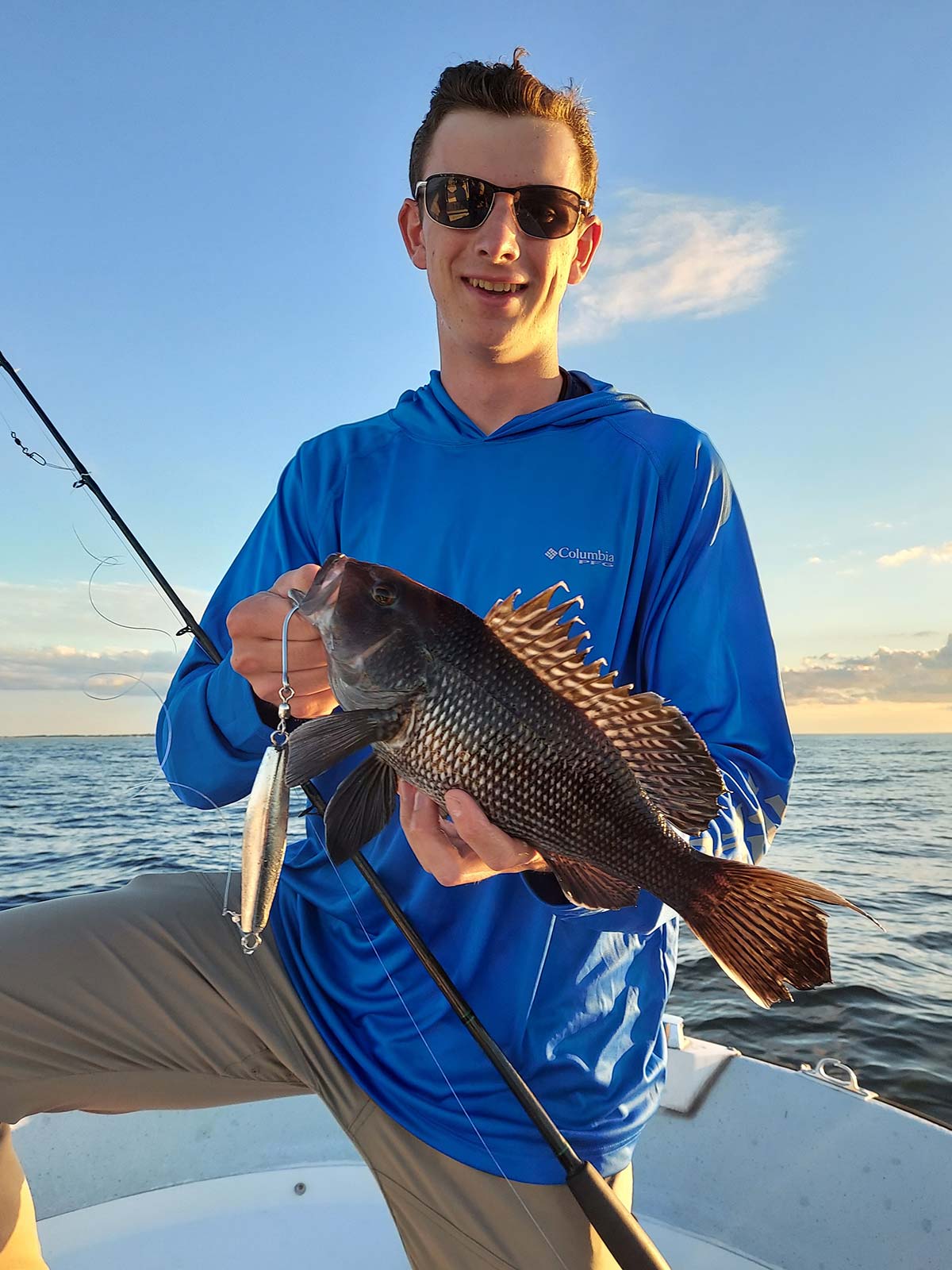
How To Fish A Diamond Jig
There are several ways to work a diamond jig, depending on the species you’re targeting, but for sea bass, bluefish-style speed-jigging isn’t the most productive method because you’re quickly retrieving your jig out of the sweet spot. Also not effective is the “swing-for-the-fences” approach with long and fast upward rod sweeps – good for stripers or cod – but not so much for sea bass.
The right technique is subtler, keeping the metal bouncing right along the bottom, as if tending a sinker, but using short 12-inch strokes by snapping the rod tip up and imparting a motion like a fluttering baitfish just inches off the bottom. Expect to hang up occasionally, and maybe lose a jig or two, but it’s worth the reward.
A diamond’s drop is just as vital as its lift. Because of its unique shape, it can flutter sideways toward the bottom, an action which resembles a wounded or spawning baitfish. You can achieve this action by quickly dropping the rod tip. If you drop your tip too slowly, however, the line resistance will hold your jig vertical with less horizontal fluttering motion.
“It’s important to keep your jig near the bottom,” says Capt. Ned, “or no more than a ‘rod-tip-length’ off the bottom, imparting a short-but-exact and fairly-swift jigging motion. These fish prefer structure, and rarely venture too far up to feed. But don’t lose complete contact with the jig, as the strike often comes on the drop. The technique requires practice and touch.”
Speed jigging or “squidding” will also work but with a slower cranking action and not more than about six turns up off the bottom (compared to about 10 turns for bluefish and stripers). Again, the drop is important, so allow your lure to free-spool as quickly as possible to achieve a fluttering motion. And then hang on!
